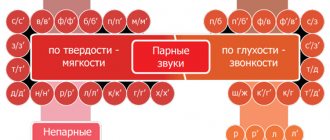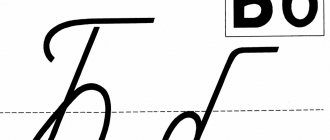Today the letter Y is with us.
An interesting analogy: a person who wants to isolate himself (put himself first), as a rule, says left and right: “I did this…. I am so and so... I... I... I...".
And those listening to him with a grin (well, or with indignation) snapped: “I am the last letter in the alphabet .
What do they mean by this?
But they want to say that you should not stick your head out with your omnipresent “I”, because you need to be quicker in life.
And I decided to get to know “I” better. I learned a lot of interesting things about her, so I decided to introduce you to her.
When did the removal of letters from the alphabet begin?
During the period of Soviet power, it was decided to move the letter “Ya” to the last place, since “Izhitsa” was practically no longer used by that time.
Only in church texts could one see it. It is interesting that the Bolsheviks did not react to the removal of Izhitsa from the alphabet; then it seemed to everyone that the authorities had decided to simply abandon one of the sacraments - confirmation.
After all, Izhitsa was used in the word “mirro”. And having abandoned the letter that is part of this word, it seemed to many that the very giving of the gifts of the Holy Spirit was abolished as a means of strengthening his spiritual life.
The removal of “Izhitsa” was not documented, but the elimination of “fita” became the final appointment of the letter Ya as the final letter of the Russian alphabet.
Phonetic analysis of words step by step.
1. Write down the word, put emphasis. If you are lost and cannot accurately place the stress, try, by transferring the stress between syllables, to choose the most harmonious option for you. For example, most people from the stress options: milk, milk, milkO, will naturally choose the last one, as the most understandable and correct.
2. Below, write down the letters and the sounds they make, each sound on a new line. If at the sound stage you do not know how to pronounce a word correctly, write down the sounds as you hear them, relying on your own pronunciation of a particular word.
3. Mark vowel sounds, indicate stressed and unstressed sounds. It’s easier with vowels, so we describe them first, so as not to be distracted later when analyzing consonants. Frequent errors are associated with the unstressed vowels I, E after consonants, which give the sound [I], as well as with the unstressed O, which gives the sound [A].
4. Mark the remaining consonant sounds, indicate whether they are voiced or voiceless, paired or unpaired, hard or soft. If you have forgotten what voiced and unvoiced sounds are, then try to understand intuitively whether the sound is voiced or unvoiced in pronunciation. Try to find a pair yourself, remember the first 6 consonant letters of the alphabet; if a paired sound does not come to mind, then most likely the sound is unpaired. Hardness or softness can also be clearly distinguished by pronunciation, even without remembering the rules.
5. Count the total number of sounds and letters. There may be fewer, more or as many sounds as there are letters in the word. Be careful at the final stage of phonetic analysis!
Pronunciation and spelling of "I"
If we listen to the sound of the letter and pronounce it for a long time, we will hear the following sounds [y-a-a-a-a-a-a].
If a letter stretches when sounded, it is a vowel.
The letter I consists of two sounds, a short consonant sound [th] and a vowel sound [a], and it can be sung. This sound feature is called iotation.
I = [й′] [a] - this is how the sounds included in the letter I are designated in transcription.
We see that there is one letter, and there are two sounds in it, one of which Yot is a consonant. In writing it is designated as Y, which is why it is called iotized.
At the beginning of a word or after vowels and separators, we hear the consonant J, and then the vowel sound A.
After consonants, I often softens them: blunder. Here L is pronounced softly thanks to Ya.
But this is only if “I” is in the position of a stressed syllable.
In the unstressed position, “I” seems to repeat the sounds E and I: fields - field.
If I is heard after hissing (ch, sch, sh, zh), guttural (x, g, k), after c, this does not mean that it is written after them. Not at all. We write “a” in these cases.
This rule does not apply only to foreign words, such as: Siauliai, Djakovitsa, Mkrtchyan, etc. Here we write “I” even after sibilants.
The letter “I” in a word is a separate syllable, in a sentence it is an independent word. In some cases, the letter I appears as a whole sentence, for example:
— Who will go to the museum next week?
- I!
Introductory video about phonetic analysis
After watching the video, be sure to consolidate everything carefully reading the article! So, everything from the very beginning and in order! In the Russian alphabet, as you know, there are 33 letters , but there are more sounds that these letters can make in words when pronounced, namely 42 sounds . During phonetic analysis, it is customary to enclose sounds for designation in square brackets []. The sound recorded in a letter in phonetics is also called transcription. That is, the letter a, the sound [a]. You can also indicate that the transcription of the letter a is [a].
Moreover, there are 10 vowel letters in the alphabet. These are the letters: A, O, U, Y, E, I, Ya, E, Yu, E. But, oddly enough, there are fewer vowel sounds. There are 6 vowel sounds in total: [A], [O], [U], [Y], [E] and [I].
Why is that? This is because the vowel letters Ya, Yo, Yu, and E do not produce separate vowel sounds. When Ya, Yo, Yu, and E come after consonants, they most often produce the sounds [A], [O], [U] and [E]. When I, Yo, Yu, and E come at the beginning of words, after vowels, soft or hard signs, they, as a rule, give combinations of sounds that are written as [Y'][A], [Y'][O ], [Y'][U] and [Y'][E], respectively.
There are 2 more interesting letters in the alphabet: b and b. Soft and hard signs do not give independent sounds, but why are they needed then, and where are the other 36 sounds... There are still 21 consonant letters left in the alphabet: B, V, G, D, Zh, Z, J, K, L, M, N, P, R, S, T, F, X, Ts, Ch, Sh, Sh. These are the ones, in combination with vowels and a soft sign, that give the remaining 36 sounds - these are [b], [b '], [c], [v'], [d], [g'], [d], [d'], [g], [z], [z'], [th'], [k ], [k'], [l], [l'], [m], [m'], [n], [n'], [p], [p'], [p], [p' ], [s], [s'], [t], [t'], [f], [f'], [x], [x'], [ts], [h'], [w] , [sch'].
That is, for example, the letter B in words can give a hard sound and is written as [b]. For example, in the word “barrel”. Also, B can give a soft sound, which is written almost the same way, but with a small quotation mark (apostrophe) - [b']. For example, the soft sound [b'] in the words: shore, obliged, individual. The soft sign, by the way, in the last word, together with the letter B, gave the necessary soft sound. This is actually what it is used for. The hard sign, in turn, is used to separate sounds in a word, for example, in the words entrance, ate, disconnect.
Poems about the letter I
This letter is clear, bright, beautiful. My letter loves all the words where the letter I is.
Both at the beginning and at the end: Both on the Yacht and in the Egg. In the fields - here in the middle. Ali has it, Nina doesn’t.
Look carefully - the letter is interesting!
***
The letter I lived in an egg. At the beginning of the word, not at the end. And then, such a thief, multiplied in the word “Lala”.
All vowels survived. And there are consonants nearby. In “lyalya” I got used to it, I became friends with the consonant L.
***
Audio poem about the letter I
Rules of phonetic analysis.
We figured out all the letters and sounds. Let's move on to the rules of phonetic parsing directly. As we understand, by definition, sounds can be vowels and consonants .
Phonetic analysis of vowels
Depending on the stress in a word, vowel sounds can be stressed or unstressed . As you already understand, the sounds [i], [e], [yu], [e] do NOT exist. The letters Ya, Yo, Yu, and E after consonants give the sounds [A], [O], [U] and [E], respectively. When I, Yo, Yu, and E are after vowels, a soft, hard sign or at the beginning of a word, they give the sounds [Y'][A], [Y'][O], [Y'][U] and [Y '][E]. an exception for Ya and E , when they are unstressed, then they give the sound [I] after all consonants except Zh, Sh and Ts. For example, rowan [r'ib'ina], steppe [st❜ipnoy❜]. After Zh, Sh and C, unstressed E and Ya give the sound [Y] instead of [I]. For example, in the word zaytsev [zay'tsyf]. In other cases, unstressed I and E give [Y'][I]. For example, in the word language [y'izyk].
All other vowel letters A, O, U, Y, E and I give the corresponding sounds [A], [O], [U], [Y], [E] and [I], except for the case when the letter O is without stress, then it gives the sound [A], for example in the word window [akno].
How to remember the phonetics of vowel sounds? With vowels everything is quite simple. It is necessary to remember 4 letters that do not give independent sounds I, E, Yu, and E. They give the corresponding sounds [A], [O], [U] and [E] after consonants, softening them. In other situations, during phonetic analysis of Ya, Yo, Yu, and E, [Y'] is added before [A], [O], [U] and [E]. The exception is when I and E are unaccented, then they give [I] after consonants, sometimes [Y] (after Zh, Sh and Ts), and [Y'] [I] in other cases. The remaining 6 vowels A, O, U, Y, E and I give the same sounds [A], [O], [U], [Y], [E] and [I], with the exception of unstressed O, which gives sound [A].
Phonetic analysis of consonants
Consonants, in turn, are divided into voiced and voiceless/paired and unpaired . Voiced and unvoiced paired sounds are respectively: [b]-[p] [v]-[f] [g]-[k] [d]-[t] [zh]-[w] [z]-[s] and their soft “analogues” [b']-[p'], [v']-[f'], etc.
Voiced unpaired sounds (also sonorant): [Y'], hard [L], [M], [N] [R] and soft [L'], [M'], [N'] [R']. Voiceless unpaired: [Х], [Х'], [Ц], [Ч'] and [Ш'].
Consonants in words can also be hard or soft . According to the general rule of phonetics, before the letters A, O, U, Y, E and Ъ, consonant letters give hard sounds, except for the letters CH, Shch and Y, they always give soft sounds, regardless of what letter follows them. Before I, Ya, Yo, Yu, E and b, consonant letters give soft sounds, except for Ж, Ш and Ц, they always give hard sounds. We also remember that I, Yo, Yu, E after consonants give the sounds [a], [o], [u], [e] without [Y']. In individual words, E can be heard as [E], without softening the preceding consonant and without adding [Y'] when the previous letter is not a consonant. For example, the word test is heard as [test], cafe [cafe], project [proekt].
Also, regarding the phonetic analysis of consonants, it is important to know: 1. A voiced consonant letter can produce a voiceless sound, and vice versa, a voiceless letter can produce a voiced sound . If in a word the letter giving a paired voiced sound is the last one or is followed by a letter giving a voiceless sound, then the voiced sound is “muted”, that is, instead of the voiced sound, its voiceless pair is written in the transcription. For example, the word claws is given in transcription [kokt'i], ditch in transcription [rof]. And vice versa. Voiceless consonant letters before voiced sounds (except for [в]) are “voiced”, that is, they give voiced sounds. That is, instead of [S] we hear [Z], instead of T - D, in place of K - G, and so on. For example, in the phonetic analysis of a word, make a transcription (sound of the word) [z'd'elat'] 2. Combinations of consonant letters can produce other sounds. СЧ, ЗЧ are pronounced as [Ш]. The combination of TС, TS, DS gives [C]. CHN and CHT in some words can produce the sounds [ШН] and [ШТ]. For example, in the word counting transcription [sh'otny'], learn [uch'itsa], hint [patskask], of course [kan'eshna], that [into]. 3. Individual consonants in words may NOT produce sounds in a number of cases. 3.1 When the letters STN and STL follow each other in a word, the consonant [T], as a rule, is not pronounced. For example, Lenten transcription [posny], passionate [passionate'], happy [sh'asl'ivy']. 3.2. When identical consonants follow each other. For example, in the word class, transcription [class]. Or for example, in the word knee transcription [kol'en:y']. NN in this case is marked in transcription with a colon, which means that the sound is prolonged, that is, it drags out a little when pronounced. 3.3. Also, in a number of cases, when two or more consonant letters follow each other, one of them is not pronounced. For example, in the word rest the transcription [ad:ahnut'], pilot [l'och'ik], sun [sontse], late [pozna], heart [s'erts:e], sew [shyt'], burn [ zhech']. In practice, problems with phonetic analysis of such cases, as a rule, do not arise, since the loss of sounds is naturally heard when pronouncing a word.
How easy is it to remember the phonetic characteristics of consonant sounds? Remembering the basic characteristics of consonant sounds is actually not difficult. A voiced or unvoiced sound is easy to determine by its sound. Voiceless sounds are pronounced as if by “exhalation” or “noise”; voiceless sounds are a little easier to pronounce than voiced sounds. By going through the pronunciation of voiceless and voiced sounds, you will quickly catch the difference and learn to easily distinguish them. It is also not difficult to remember paired sounds. There are only 6 main pairs of sounds, it is quite difficult to confuse them with each other. Moreover, all 6 voiced sounds from the pairs are the sounds of the first 6 consonant letters of the alphabet one after another. A, B, C, D, E, E, E, F, G ... Hardness and softness in most cases are easy to understand by simply saying the word. For example, just compare the sound of the letter d in the words house and children.
This is the basic knowledge that is important to learn for phonetic analysis. All that remains is to master the analysis itself in practice. Due to the large number of features and exceptions, you are unlikely to be able to immediately parse words without errors, but the more you practice, the better you will get at it.
Funny riddles about the letter I
► First, there are several riddles - deceptions, when the rhyme makes you want to say one letter, but in fact the answer is a completely different letter. Author – I. Ageeva
Farthest away, right at the end, the letter in the alphabet is...
Answer: not C, but I
► The author of this riddle is N. Punko, it needs to be continued in rhyme, substituting the desired letter
An apple grows on a branch, our children love it. I love the apple too - I’ll remember the letter with it...
► In this riddle you must first guess the words in question, and then the letter with which these words begin. Its author is Olesya Emelyanova.
They bite the letter on the sides, throw it into the sea from a ship, snakes do evil with it, people make speeches.
Answer: letter I (apple, anchor, poison, tongue)
► Another traditional riddle. Its author is A. Khrebtyugov.
Don’t suddenly pronounce this word - this letter! You’ll start a story about yourself, so you’ll call her!







